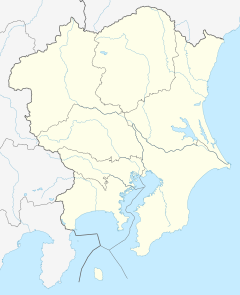Mizunuma Station
This article needs additional citations for verification. (August 2020) |
WK08 Mizunuma Station 水沼駅 | ||||||||||||||||
|---|---|---|---|---|---|---|---|---|---|---|---|---|---|---|---|---|
 Mizunuma Station, June 2005 | ||||||||||||||||
| General information | ||||||||||||||||
| Location | 151 Mizunuma Kurohone-cho, Kiryū City, Gunma Prefecture 376-0141 Japan | |||||||||||||||
| Coordinates | 36°30′00″N 139°16′40″E / 36.5000°N 139.2777°E | |||||||||||||||
| Operated by | Watarase Keikoku Railway | |||||||||||||||
| Line(s) | Watarase Keikoku Line | |||||||||||||||
| Distance | 16.9 km (10.5 mi) from Kiryū | |||||||||||||||
| Platforms | 2 side platforms | |||||||||||||||
| Tracks | 2 | |||||||||||||||
| Construction | ||||||||||||||||
| Structure type | At grade | |||||||||||||||
| Other information | ||||||||||||||||
| Status | Unstaffed | |||||||||||||||
| Station code | WK08 | |||||||||||||||
| Website | Official website | |||||||||||||||
| History | ||||||||||||||||
| Opened | 5 September 1912 | |||||||||||||||
| Previous names | Mizunuma Teisha-jo (until 1918) | |||||||||||||||
| Passengers | ||||||||||||||||
| FY2019 | 99 | |||||||||||||||
| Services | ||||||||||||||||
| ||||||||||||||||
| Location | ||||||||||||||||

Mizunuma Station (水沼駅, Mizunuma-eki) is a railway station in the city of Kiryū, Gunma, Japan, operated by the third sector railway company Watarase Keikoku Railway.
Lines[edit]
Mizunuma Station is a station on the Watarase Keikoku Line and is 16.9 kilometers from the terminus of the line at Kiryū.
Station layout[edit]
The station has a two opposed side platforms connected by a level crossing. The station is unattended.
History[edit]
Mizunuma Station opened on 5 September 1912 as Mizunuma Teishajo (水沼停車場) on the Ashio Railway. It was renamed to its present name on 1 June 1918.
Passenger statistics[edit]
In fiscal 2019, the station was used by an average of 99 passengers daily (boarding passengers only).[1]
Surrounding area[edit]
- former Mizunuma Village Hall
- Mizunuma Post Office
 National Route 122
National Route 122
See also[edit]
References[edit]
- ^ 市内鉄道の年間乗降客数 [Annual number of passengers on the city rail] (in Japanese). Japan: Kiryū City. 2020. Retrieved 2 August 2020. (in Japanese)
External links[edit]
Wikimedia Commons has media related to Mizunuma Station.
- Station information (Watarase Keikoku) (in Japanese)



